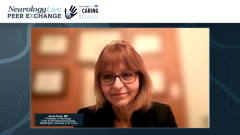
Understanding Varying Latency Periods for Epstein-Barr Virus and Onset of MS
Alberto Ascherio, MD, DrPH, addresses the range of latency periods for Epstein-Barr virus and the impact on onset multiple sclerosis.
Episodes in this series

Scott Newsome, DO: Anne, you were ready to jump into the conversation. When Mike started talking about NfL [neurofilament light chain], I could see you were like, “It’s not specific to MS.”
Anne Cross, MD: That’s 1 thing, but I was thinking about all those children who get Epstein-Barr virus [EBV] when they’re under 5 years old. If they’re destined to get MS [multiple sclerosis], they’re going to have a long latent period. Why would that be in some people vs a year or 2 in another person? That gets back to my question to Alberto about people who have symptomatic mononucleosis when they’re in their teens or early 20s. What’s different about that that seems to convey an even larger risk?
Alberto Ascherio, MD, DrPH: Individuals with mononucleosis have massive EBV infection with an extremely high viral load and even more overwhelming cytotoxicity response. For a few weeks, you have a storm of B cells and T cells proliferating. One important thing is that at that stage, some of these B cells infiltrate within the CNS [central nervous system] and go to the brain. Maybe they establish there’s some nature in which they can survive inside the brain. This is 1 of the hypotheses that has been proposed. I don’t think it’s surprising that mononucleosis is associated with higher risk of MS, given that EBV is a cause of MS, because you have much more virus than in people who are symptomatic and much more aggressive immune response against the virus. That makes some sense in a common way. Not in a technical way, but in an intuitive way. Like with COVID-19, where an overwhelming infection is more likely to get you more sick. But the delay is a very good question.
There are cases of MS that occur 10, 15, and 20 years after the infection. What’s going on in that time? One possibility of this dynamic is that the relation between the virus and immune system isn’t static, at least not in all people. The virus tends to reactivate, and periodically the immune system will suppress it. In this process of reactivation and suppression, maybe something emerged, whether it’s a bit of spreading molecular mimicry or collateral damage. At some point in this dynamic, a pathological direction is taken. I’m not an immunologist. I’m giving you possible intuitive things from a distance.
Scott Newsome, DO: I was going to ask Avi, because that’s very curious to me to have such different latencies between the prime infection and then the autoimmune disease. Avi, beyond what Alberto just mentioned, what other things come to mind that could explain that huge latency between pediatric-onset MS and someone in their 60s developing MS, at least symptomatic MS?
Avindra Nath, MD: I don’t know the answer, but the phenomenon is well known. You get chickenpox as a child, but you get shingles when you’re older. There are a lot of other things. It’s the same thing with people who associate herpesvirus with Alzheimer disease. You’re getting HSV-1 [herpes simplex virus 1] infection very early, while Alzheimer disease occurs so late. Who knows if that association is true. But it’s the same idea of long latency.
With viral infections in the CNS, you can get long latencies. We’ve seen patients who get infected with dengue very early on and then many years later start developing encephalitis and neurodegeneration from it. Nipah virus is the same thing. You have 20 years of latency before you can get encephalitis. That’s a well-known phenomenon. I don’t know what’s happening during that time. Maybe the virus is latent and gets reactivated at some point and then the immune system reacts very differently upon the time of reactivation. It’s quite possible. Or something else is happening. All these proteinopathy people will say it’s promoting protein aggregation, and it takes a certain threshold to get to and then triggers things. I don’t know the answer, but these are possibilities.
Transcript Edited for Clarity
Newsletter
Keep your finger on the pulse of neurology—subscribe to NeurologyLive for expert interviews, new data, and breakthrough treatment updates.

























